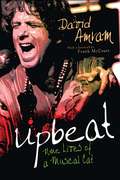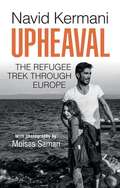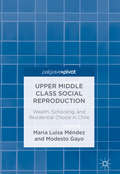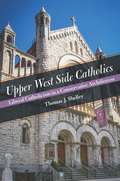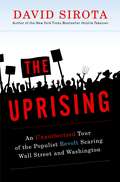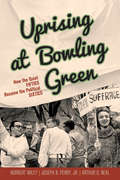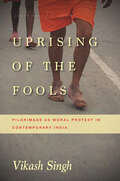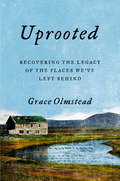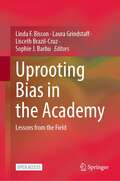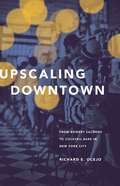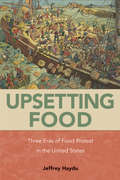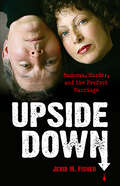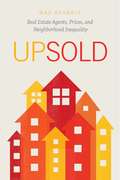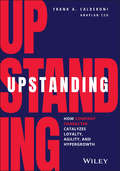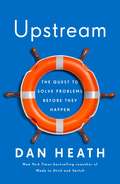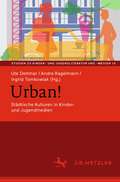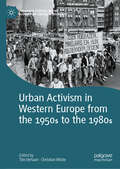- Table View
- List View
Upbeat: Nine Lives of a Musical Cat
by David AmramDavid Amram-composer, jazz artist, conductor, and world music pioneer-has been described by the Boston Globe as "the Renaissance man of American music." From early collaborations with Kerouac and Sinatra, chosen by Leonard Bernstein as the New York Philharmonic's first composer in residence, Amram's artistry has taken him from concerts with Willie Nelson to jamming with the Massai tribe of Kenya. In Upbeat: Nine Lives of a Musical Cat, Amram recounts his extraordinary adventures in the many worlds of music he calls home, all told in a rollicking anecdotal style that makes you feel that you are at home around the world. He writes, "Everywhere I have been in the world, music transcends politics. As musicians, we were able to go beyond all that and just be fellow human beings." Threading through Amram's tale of music, hard work, respect, and friendship are unforgettable stories of fellow great artists-Dizzie Gillespie, Hunter S. Thompson, Janet Gaynor, George Plimpton, Lyle Lovett, Zoe Caldwell, Willie Nelson, and many more.
Updating Charles H. Cooley: Contemporary Perspectives on a Sociological Classic (Classical and Contemporary Social Theory)
by Natalia Ruiz-Junco Baptiste BrossardThis book explores the contemporary relevance of Charles H. Cooley’s thought, bringing together scholars from the US, Europe and Australia to reflect on Cooley’s theory and legacy. Offering an up-to-date analysis of Cooley’s reception in the history of the social sciences, an examination of epistemological and methodological advances on his work, critical assessments and novel articulations of his major ideas, and a consideration of new directions in scholarship that draws on Cooley’s thought, Updating Charles H. Cooley will appeal to sociologists with interests in social theory, interactionism, the history of sociology, social psychology, and the sociology of emotions.
Upheaval: The Refugee Trek through Europe
by Navid KermaniBy foot, in buses, prison vans and trains, a steady stream of refugees traveled from the Greek island of Lesbos into Europe. In the autumn of 2015, award-winning writer Navid Kermani decided to accompany them on the "Balkan route." In this perceptive account from the front line of the "refugee crisis," Kermani shows how a seemingly distant world in which war and conflict rage has suddenly collided with our own. Kermani describes the situation on the Turkish west coast where thousands of refugees live in the most desperate conditions, waiting to take the perilous journey across the Mediterranean. Then, on Lesbos, he observes the culture shock amongst those who have survived the ordeal by sea. He speaks to aid workers and politicians, but most importantly of all to the refugees themselves, asking those who have come from Syria, Iraq, Afghanistan and elsewhere what has driven them to risk everything and embark on the long and treacherous journey to Europe. <p><p> With great sensitivity Kermani reveals, often through small details, the cultural and political upheaval that has caused people to uproot their lives, and at the same time shining a light on Europe's inadequate and at times openly hostile response to the refugees. Interspersed with powerful images by the acclaimed photographer Moises Saman, Upheaval is a much-needed human account of a crisis we cannot ignore.
Upon Further Review: The Greatest What-Ifs in Sports History
by Mike PescaFrom Mike Pesca, host of the popular Slate podcast The Gist, comes the greatest sports minds imagining how the world would change if a play, trade, injury, or referee's call had just gone the other way. p.p1 {margin: 0.0px 0.0px 0.0px 0.0px; font: 12.0px Calibri} p.p2 {margin: 0.0px 0.0px 0.0px 0.0px; font: 12.0px Cambria} p.p3 {margin: 0.0px 0.0px 0.0px 0.0px; font: 12.0px Cambria; min-height: 14.0px} No announcer ever proclaimed: "Up Rises Frazier!" "Havlicek commits the foul, trying to steal the ball!" or "The Giants Lose the Pennant, The Giants Lose The Pennant!" Such moments are indelibly etched upon the mind of every sports fan. Or rather, they would be, had they happened. Sports are notoriously games of inches, and when we conjure the thought of certain athletes - like Bill Buckner or Scott Norwood - we can't help but apply a mental tape measure to the highlight reels of our minds. Players, coaches, and of course fans, obsess on the play when they ask, "What if?" Upon Further Review is the first book to answer that question.Upon Further Review is a book of counterfactual sporting scenarios. In its pages the reader will find expertly reported histories, where one small event is flipped on its head, and the resulting ripples are carefully documented, the likes of... What if the U.S. Boycotted Hitler's Olympics? What if Bobby Riggs beat Billie Jean King? What if Bucky Dent popped out at the foot of the Green Monster?What if Drew Bledsoe never got hurt? Upon Further Review takes classic arguments conducted over pints in a pub and places them in the hands of dozens of writers, athletes, and historians. From turning points that every sports fan rues or celebrates, to the forgotten would-be inflection points that defined sports, Upon Further Review answers age old questions, and settles the score, even if the score bounced off the crossbar.
Upper Echelons’ Naturalistic Decision-Making and Top Management Team Macrocognition in a High Reliability Organization
by Leonie LooserThe book analyzes crisis decision-making of a major German airline's operational top management team during the Covid-19 crisis. The operational top manager's relevant decision-making entity, the crisis management team, was faced with substantial time-critical decisions in volatile circumstances as well as the need to balance ambidextrous exigencies with the operation's short-term survival as well as its future viability. The author applies her ethnographic perspective and develops an analysis based on the unique combination of naturalistic decision-making, top management team research, high reliability organizations and ambidexterity as well as team diversity. The work is targeted at both management professionals, as it identifies best pratices and learnings from a polycrisis case, as well as researchers, as it makes a novel contribution to decision-making in the context of high reliability organizations.
Upper Hand: The Future of Work for the Rest of Us
by Sherrell DorseyLearn how to secure a place at the professional table for Black, Latinx, and other marginalized groups In Upper Hand: The Future of Work for the Rest of Us, celebrated Founder and CEO of The Plug, Sherrell Dorsey, delivers a personal and eye-opening exploration of how to ensure that marginalized communities aren't left behind as technology continues its inexorable march forward. In the book, readers will learn to think about how we can strategically shape the coming decade to include Black and Brown communities. Upper Hand offers guidelines, insights, and frameworks for navigating the new world of work that is dominated by Silicon Valley-rooted technologies, inaccessible networks, and constant automation that continues to slash jobs in the Black and Latinx population. You'll find ways to: Help families and community leaders design clear pathways to understanding alternatives to obsolescence Thrive in an ever-changing, tech-driven economy that is beginning to leave people of color behind Embrace new strategies that guarantee a place for Black and brown people in the new economy The startling and insightful discussion in Upper Hand will earn it a place in the libraries of families, teachers, community advocates, workforce development leaders, professionals of color, as well as anyone interested in learning how to distribute the benefits of the new tech economy to those historically left out.
Upper Middle Class Social Reproduction: Wealth, Schooling, and Residential Choice in Chile
by María Luisa Méndez Modesto GayoIn the contemporary context of increasing inequality and various forms of segregation, this volume analyzes the transition to neoliberal politics in Santiago de Chile. Using an innovative methodological approach that combines georeferenced data and multi-stage cluster analysis, Méndez and Gayo study the old and new mechanisms of social reproduction among the upper middle class. In so doing, they not only capture the interconnections between macro- and microsocial dimensions such as urban dynamics, schooling demands, cultural repertoires and socio-spatial trajectories, but also offer a detailed account of elite formation, intergenerational accumulation, and economic, cultural, and social inheritance dynamics.
Upper West Side Catholics: Liberal Catholicism in a Conservative Archdiocese
by Thomas J. ShelleyThis remarkable history of a beloved Upper West Side church is in many respects a microcosm of the history of the Catholic Church in New York City.Here is a captivating study of a distinctive Catholic community on the Upper West Side of Manhattan, an area long noted for its liberal Catholic sympathies in contrast to the generally conservative attitude that has pervaded the archdiocese of New York. The author traces this liberal Catholic dimension of Upper West Side Catholics to a long if slender line of progressive priests that stretches back to the Civil War era, casting renewed light on their legacy: liturgical reform, concern for social justice, and a preferential option for the poor long before this phrase found its way into official church documents. In recent years this progressivism has demonstrated itself in a willingness to extend a warm welcome to LGBT Catholics, most notably at the Church of the Ascension on West 107th Street. Ascension was one of the first diocesan parishes in the archdiocese to offer a spiritual home to LGBT Catholics and continues to sponsor the Ascension Gay Fellowship Group.Exploring the dynamic history of the Catholic Church of the Ascension, this engaging and accessible book illustrates the unusual characteristics that have defined Catholicism on the Upper West Side for the better part of the last century and sheds light on similar congregations within the greater metropolis. In many respects, the history of Ascension parish exemplifies the history of Catholicism in New York City over the past two centuries because of the powerful presence of two defining characteristics: immigration and neighborhood change. The Church of the Ascension, in fact, is a showcase of the success of urban ethnic Catholicism. It was founded as a small German parish, developed into a large Irish parish, suffered a precipitous decline during the crime wave that devastated the Upper West Side from the 1960s to the 1980s, and was rescued from near-extinction by the influx of Puerto Rican and Dominican Catholics. It has emerged during the last several decades as a flourishing multi-ethnic, bilingual parish that is now experiencing the restored prosperity and prominence of the Upper West Side as one of Manhattan’s most integrated and popular residential neighborhoods.
The Uprising: An Unauthorized Tour of the Populist Revolt Scaring Wall Street and Washington
by David Sirota[From the book jacket] An All-Access Pass to the Populist Insurrection Brewing Across the Country Job outsourcing. Perpetual busy signals at government agencies. Slashed paychecks. Stolen elections. A war without end, fatally mismanaged. Ordinary Americans on both the Right and Left are tired of being disenfranchised by corrupt politicians of both parties and are organizing to change the status quo. In his invigorating new book, David Sirota investigates whether this uprising can be transformed into a unified, lasting political movement. Throughout the course of American history, uprisings like the one we are seeing now have given birth to powerful movements to end wars, protect workers, and expand civil rights, so the prospect of today's uprising turning into a full- fledged populist movement terrifies Wall Street and Washington. In The Uprising, Sirota takes us far from the national media spotlight into the trenches where real change is happening - from the headquarters of the most powerful third party in America to the bowels of the U.S. Senate; from the auditorium of an ExxonMobil shareholder meeting to the quasi-military staging area of a vigilante force on the Mexican border. This is vital, on-the-ground reporting that immerses us in the tumultuous give-and-take of politics at its most personal. Sirota also offers a biting critique of our politics. He shows how the uprising is, at its core, a reaction to faux "bipartisanship" in the nation's capital - the "bipartisanship" whereby Republican and Democratic lawmakers join together in putting the agenda of corporate interests above all those of ordinary citizens. Ultimately, Sirota reminds us that the Declaration of Independence, "America's original uprising manifesto," says that governments "derive their powers from the consent of the governed." Irreverent and insightful, The Uprising shows how the governed have stopped consenting and have started taking action.
Uprising at Bowling Green: How the Quiet Fifties Became the Political Sixties
by Norbert Wiley Arthur G. Neal Joseph B Perry JrOften overlooked, the student demonstration at Bowling Green State University was the first and most successful 1960s campus protest - and a key point in the transition from 1950s social mores to 1960s activism. What began as a protest against outdated rules about dating and student behaviour quickly turned toward political objectives about civil liberties and ousted the university president. The authors, two of whom were present on campus during the demonstration, tell the story of how what began as dissent against old schoolmarm rules quickly turned into a fully-fledged 1960s crusade, with new issues and tactics. Feminist activists played a leading role, and the uprising succeeded in advancing the civil liberties of women. Drawing on the sociological ideas of Weber, Durkheim, and Marx, this book depicts how young activists broke the 1950s mold, little aware that many of their ideals would be echoed in many important 1960s protests. It is a vivid portrait of how the 1950s became the 1960s in America.
Uprising of the Fools: Pilgrimage as Moral Protest in Contemporary India
by Vikash SinghThe Kanwar is India's largest annual religious pilgrimage. Millions of participants gather sacred water from the Ganga and carry it across hundreds of miles to dispense as offerings in Siva shrines. These devotees—called bhola, gullible or fools, and seen as miscreants by many Indians—are mostly young, destitute men, who have been left behind in the globalizing economy. But for these young men, the ordeal of the pilgrimage is no foolish pursuit, but a means to master their anxieties and attest their good faith in unfavorable social conditions. Vikash Singh walked with the pilgrims of the Kanwar procession, and with this book, he highlights how the procession offers a social space where participants can prove their talents, resolve, and moral worth. Working across social theory, phenomenology, Indian metaphysics, and psychoanalysis, Singh shows that the pilgrimage provides a place in which participants can simultaneously recreate and prepare for the poor, informal economy and inevitable social uncertainties. In identifying with Siva, who is both Master of the World and yet a pathetic drunkard, participants demonstrate their own sovereignty and desirability despite their stigmatized status. Uprising of the Fools shows how religion today is not a retreat into tradition, but an alternative forum for recognition and resistance within a rampant global neoliberalism.
The Uprising of Women in Philanthropy
by Musimbi Kanyoro Ana Oliveira Helen LaKelly Hunt Ndana Bofu-Tawamba Ruby Bright Stephanie Clohesy Christine Grumm Laura Risimini Jane Sloane Jessica TomlinThe Uprising of Women in Philanthropy tells the inspiring, never-before-told, story of the Global Women’s Funding Movement—considered the women’s movement’s greatest secret—and how it enabled women from all walks of life to harness the power of money to free themselves from oppression.Brimming with feminist epiphanies, this social justice playbook is an urgent call for women’s collective leadership to guide humanity through the gravest of challenges, overcoming patriarchy’s multi-millennium reign through the uprising of women leaders and philanthropists. Founded during the second-wave women’s movement of the early 1970s, small groups of women across the world, independent of each other, had the same epiphany: it will take a movement of women to raise the money needed to fund women’s freedom. Since then, the Global Women's Funding Movement has grown into a global network of radically generous, risk-taking philanthropists who collectively wield financial might to win seismic gender equality victories. The authors document the "Women Effect" that results from gender equality and women’s collective leadership, including improved public health and reproductive justice, expanded public education, stronger democracies, resilient economies, climate recovery and enduring peace. The Global Women's Funding Movement is guided by its Feminist Funding Principles and, through them, it has innovated the most effective philanthropic practices, including trust-based philanthropy.The Uprising of Women in Philanthropy is for those interested in focusing the power of philanthropy on leveraging systemic social justice victories and gender equality gains. The long-practiced Feminist Funding Principles imparted by the authors is a recipe for the feminist alchemy needed to transform society for the betterment of all.
Upriver
by Michael F. BrownIn this remarkable story of one manâe(tm)s encounter with an indigenous people of Peru, Michael Brown guides his readers upriver into a contested zone of the Amazonian frontier, where more than 50,000 Awajúnâe"renowned for their pugnacity and fierce independenceâe"remain determined, against long odds, to live life on their own terms. When Brown took up residence with the Awajún in 1976, he knew little about them other than their ancestorsâe(tm) reputation as fearsome headhunters. The fledgling anthropologist was immediately impressed by his hostsâe(tm) vivacity and resourcefulness. But eventually his investigations led him into darker corners of a world where murderous vendettas, fear of sorcery, and a shocking incidence of suicide were still common. Peruâe(tm)s Shining Path insurgency in the 1980s forced Brown to refocus his work elsewhere. Revisiting his field notes decades later, now with an older manâe(tm)s understanding of lifeâe(tm)s fragility, Brown saw a different story: a tribal society trying, and sometimes failing, to maintain order in the face of an expanding capitalist frontier. Curious about how the Awajún were faring, Brown returned to the site in 2012, where he found a people whose combative self-confidence had led them to the forefront of South Americaâe(tm)s struggle for indigenous rights. Written with insight, sensitivity, and humor, Upriver paints a vivid picture of a rapidly growing population that is refashioning its warrior tradition for the twenty-first century. Embracing literacy and digital technology, the Awajún are using hard-won political savvy to defend their rainforest home and right of self-determination.
Uprooted: Recovering the Legacy of the Places We've Left Behind
by Grace Olmstead"A superior exploration of the consequences of the hollowing out of our agricultural heartlands."—Kirkus ReviewsIn the tradition of Wendell Berry, a young writer wrestles with what we owe the places we&’ve left behind. In the tiny farm town of Emmett, Idaho, there are two kinds of people: those who leave and those who stay. Those who leave go in search of greener pastures, better jobs, and college. Those who stay are left to contend with thinning communities, punishing government farm policy, and environmental decay. Grace Olmstead, now a journalist in Washington, DC, is one who left, and in Uprooted, she examines the heartbreaking consequences of uprooting—for Emmett, and for the greater heartland America. Part memoir, part journalistic investigation, Uprooted wrestles with the questions of what we owe the places we come from and what we are willing to sacrifice for profit and progress. As part of her own quest to decide whether or not to return to her roots, Olmstead revisits the stories of those who, like her great-grandparents and grandparents, made Emmett a strong community and her childhood idyllic. She looks at the stark realities of farming life today, identifying the government policies and big agriculture practices that make it almost impossible for such towns to survive. And she explores the ranks of Emmett&’s newcomers and what growth means for the area&’s farming tradition. Avoiding both sentimental devotion to the past and blind faith in progress, Olmstead uncovers ways modern life attacks all of our roots, both metaphorical and literal. She brings readers face to face with the damage and brain drain left in the wake of our pursuit of self-improvement, economic opportunity, and so-called growth. Ultimately, she comes to an uneasy conclusion for herself: one can cultivate habits and practices that promote rootedness wherever one may be, but: some things, once lost, cannot be recovered.
Uprooted (Second Edition)
by Khetam Dahi Novia ElvinaIn a simple yet honest and powerful prose, Dahi, through the eyes of a child turning adolescent, narrates the everyday existence of immigrant and working-class families.
Uprooting Bias in the Academy: Lessons from the Field
by Linda F. Bisson Laura Grindstaff Lisceth Brazil-Cruz Sophie J. BarbuThis open access book analyzes barriers to inclusion in academia and details ways to create a more diverse, inclusive environment. It describes the implementation of UC Davis ADVANCE, a grant program funded by the National Science Foundation, to increase the hiring and retention of underrepresented scholars in the STEM fields (science, technology, engineering and mathematics) and foster a culture of inclusion for all faculty. It first describes what the barriers to inclusion are and how they function within the broader society. A key focus here is the concept of implicit bias: what it is, how it develops, and the importance of training organizational members to recognize and challenge it. It then discusses the limitations of data collection that is guided by the convention assumption that being diverse automatically means being inclusive. Lastly, it highlights the importance of creating a collaborative, interdisciplinary, and institution-wide vision of an inclusive community.
Upscaling Downtown: From Bowery Saloons to Cocktail Bars in New York City
by Richard E. OcejoOnce known for slum-like conditions in its immigrant and working-class neighborhoods, New York City's downtown now features luxury housing, chic boutiques and hotels, and, most notably, a vibrant nightlife culture. While a burgeoning bar scene can be viewed as a positive sign of urban transformation, tensions lurk beneath, reflecting the social conflicts within postindustrial cities. Upscaling Downtown examines the perspectives and actions of disparate social groups who have been affected by or played a role in the nightlife of the Lower East Side, East Village, and Bowery. Using the social world of bars as windows into understanding urban development, Richard Ocejo argues that the gentrifying neighborhoods of postindustrial cities are increasingly influenced by upscale commercial projects, causing significant conflicts for the people involved.Ocejo explores what community institutions, such as neighborhood bars, gain or lose amid gentrification. He considers why residents continue unsuccessfully to protest the arrival of new bars, how new bar owners produce a nightlife culture that attracts visitors rather than locals, and how government actors, including elected officials and the police, regulate and encourage nightlife culture. By focusing on commercial newcomers and the residents who protest local changes, Ocejo illustrates the contested and dynamic process of neighborhood growth.Delving into the social ecosystem of one emblematic section of Manhattan, Upscaling Downtown sheds fresh light on the tensions and consequences of urban progress.
Upsetting Food: Three Eras of Food Protests in the United States
by Jeffrey HayduBattle lines have long been drawn over how food is produced, what food is made available to whom, and how best to protect consumers from risky or unhealthy food. Jeffrey Haydu resurrects the history of food reform and protest in Upsetting Food, showing how activists defined food problems, articulated solutions, and mobilized for change in the United States. Haydu’s sociological history starts in the 1830s with diet reformer Sylvester Graham, who blamed alcohol and store-bought bread—signs of a commercializing urban society—for poor health and moral decline. His successors at the turn of the twentieth century rallied against impure food and pushed for women to be schooled in scientific food preparation and nutrition. Decades later, in the 1960s and ’70s, a grassroots movement for organic food battled commercial food production in favor of food grown ecologically, by small farmers, and without artificial chemicals. Each campaign raised doubts about food safety, health, and transparency, reflecting how a capitalist system can undermine trust in food. But Haydu also considers how each movement reflects the politics, inequalities, and gender relations of its time. And he traces how outcomes of each campaign laid the groundwork for the next. The three eras thus come together as parts of a single, recurring food movement. Upsetting Food offers readers a historical background to better understand contemporary and contentious food politics.
Upside Down: Madness, Murder, and the Perfect Marriage
by Jerid M. FisherTimothy Wells and Christine Sevilla's love was inspiring. Married for almost twenty years, the husband and wife passionately adored each other. Friends, family, and acquaintances all wished to have a relationship as solid as that of Tim and Christine. There was no sign that their marriage was anything less than ideal-until the day Wells brutally murdered his wife.This deep, disturbing exploration of the psyche of Timothy Wells is not a whodunit but a "whydunit." Written with Wells's cooperation, this riveting account thoroughly presents the circumstances leading up to Sevilla's murder. It features interviews and letters from the Wells and Sevilla families as well as testimony from friends, neighbors, and ex-spouses. Trapped inside his own mind, Wells' emotional insecurities left him with no escape from his severe depression and swiftly multiplying anxieties. In chilling detail, this true narrative traces the path of a man doomed by his own inner demons.
Upsold: Real Estate Agents, Prices, and Neighborhood Inequality
by Max BesbrisWhat do you want for yourself in the next five, ten years? Do your plans involve marriage, kids, a new job? These are the questions a real estate agent might ask in an attempt to unearth information they can employ to complete a sale, which as Upsold shows, often results in upselling. In this book, sociologist Max Besbris shows how agents successfully upsell, inducing buyers to spend more than their initially stated price ceilings. His research reveals how face-to-face interactions influence buyers’ ideas about which neighborhoods are desirable and which are less-worthy investments and how these preferences ultimately contribute to neighborhood inequality. ? Stratification defines cities in the contemporary United States. In an era marked by increasing income segregation, one of the main sources of this inequality is housing prices. A crucial part of wealth inequality, housing prices are also directly linked to the uneven distribution of resources across neighborhoods and to racial and ethnic segregation. Upsold shows how the interactions between real estate agents and buyers make or break neighborhood reputations and construct neighborhoods by price. Employing revealing ethnographic and quantitative housing data, Besbris outlines precisely how social influences come together during the sales process. In Upsold, we get a deep dive into the role that the interactions with sales agents play in buyers’ decision-making and how neighborhoods are differentiated, valorized, and deemed to be worthy of a certain price.
Upstanding: How Company Character Catalyzes Loyalty, Agility, and Hypergrowth
by Frank A. CalderoniThe CEO of Anaplan explains how a company’s character is a critical driver of sustained success In his career as an executive at IBM, Cisco, and now as CEO of Anaplan, Frank A. Calderoni discovered that character is just as vital for companies as it is for individuals. In Upstanding: How Company Character Catalyzes Loyalty, Agility, and Hypergrowth, the author explores the powerful link between corporate strategy, company culture, and individual character, and how activating this link is essential to realizing strong company character—and an essential ingredient for organizations to achieve hypergrowth, agility, and loyalty. This innovative resource features real-life examples of how today’s most successful companies are building upstanding character while increasing employee engagement, happiness, and performance. The book is written to help executives, company founders, managers, and other leaders develop strategies that supercharge organizational performance while building a strong and high-engagement culture—providing real-world insights from the author’s own career along with a diverse cross-section of business thought leaders and CEOs of companies both small and large, local and global. The author draws upon his experience leading a $10 billion hypergrowth software company to explain how the fusion of culture and strategy, driven by a company’s character, leads to sustained internal and external success. Designed to empower leaders to make character the cornerstone of corporate culture, this invaluable resource: Explores what “upstanding character” means for an organization, and how building a culture based on empathy, courage, authenticity, integrity, respect, and other factors drives higher performance and value creation for employees, customers, partners, and shareholders Reviews research on how culture drives performance, and operational practices for building upstanding organizational character and driving value-aligned behavior Features original interviews with Shantanu Narayen, Cy Wakeman, Eric Hutcherson, Kellie McElhaney, Geoffrey Moore, and other leaders inside and outside the tech sector Provides practical tools and approaches for increasing inclusion and belonging, improving communication, strengthening engagement, and rewarding upstanding character in employees Discusses the “Big 9” cultural values that are essential to creating upstanding company character, such as agility, collaboration, diversity, integrity, and respect With a foreword by Shantanu Narayen, Chairman and CEO of Adobe, Upstanding: How Company Character Catalyzes Loyalty, Agility, and Growth is essential reading for executives and business leaders interested in strategy, leadership, organizational culture, and management innovation, as well as leadership teams and HR professionals who are responsible for guiding their organization’s culture and developing its character.
Upstream: The Quest to Solve Problems Before They Happen
by Dan HeathWall Street Journal Bestseller New York Times bestselling author Dan Heath explores how to prevent problems before they happen, drawing on insights from hundreds of interviews with unconventional problem solvers.So often in life, we get stuck in a cycle of response. We put out fires. We deal with emergencies. We stay downstream, handling one problem after another, but we never make our way upstream to fix the systems that caused the problems. Cops chase robbers, doctors treat patients with chronic illnesses, and call-center reps address customer complaints. But many crimes, chronic illnesses, and customer complaints are preventable. So why do our efforts skew so heavily toward reaction rather than prevention? Upstream probes the psychological forces that push us downstream—including &“problem blindness,&” which can leave us oblivious to serious problems in our midst. And Heath introduces us to the thinkers who have overcome these obstacles and scored massive victories by switching to an upstream mindset. One online travel website prevented twenty million customer service calls every year by making some simple tweaks to its booking system. A major urban school district cut its dropout rate in half after it figured out that it could predict which students would drop out—as early as the ninth grade. A European nation almost eliminated teenage alcohol and drug abuse by deliberately changing the nation&’s culture. And one EMS system accelerated the emergency-response time of its ambulances by using data to predict where 911 calls would emerge—and forward-deploying its ambulances to stand by in those areas. Upstream delivers practical solutions for preventing problems rather than reacting to them. How many problems in our lives and in society are we tolerating simply because we&’ve forgotten that we can fix them?
Urban!: Städtische Kulturen in Kinder- und Jugendmedien (Studien zu Kinder- und Jugendliteratur und -medien #13)
by Ute Dettmar Andre Kagelmann Ingrid TomkowiakAls literarischer Handlungsraum hat sich die Stadt, vor allem die Großstadt, sowohl mit Blick auf die Erzählformen als auch in den semantischen Zuschreibungen innerhalb von etwa 150 Jahren grundlegend gewandelt. Im kinder- und jugendliterarischen Umgang mit den urbanen Räumen werden Veränderungen der Konstruktionen von Kindheit und Adoleszenz ebenso manifest wie die Ausdifferenzierung der Erzählformen. Heute wird Stadt als ein plurales, vielstimmiges und vielschichtiges Gefüge dargestellt, das auch von sozialen Gegensätzen geprägt und von intersektionalen Grenzlinien durchzogen ist. Die Beiträge dieses Bandes untersuchen Dimensionen und Facetten der erzählten Stadt und geben einen Einblick in das thematische und formale Spektrum kinder- und jugendliterarischer Stadterkundungen. Dabei nehmen sie Kinder- und Jugendromane, Kriminalerzählungen, Dystopien und Fantasy, Lyrik und Theater in den Blick.
Urban Activism in Western Europe from the 1950s to the 1980s (Palgrave Studies in the History of Social Movements)
by Christian Wicke Tim VerlaanBringing together contributions from social, political, and urban historians, this collection examines social movements in Western European cities from the 1950s to the 1980s. Since their post-war recovery and reconstruction, cities in this part of the world underwent far-reaching societal transitions such as deindustrialisation and the rise of the service economy, the expansion and decline of local welfare regimes, suburbanisation and urban redevelopment, and the democratisation of urban politics. Indeed, the sources for urban activism have been manifold and the rehistoricization of this era through an urban lens is therefore valuable. The authors of this volume seek to provide a comprehensive and multifaceted understanding of how structural socio-economic, political, and cultural changes; ideological shifts; and urban spaces were intertwined in various place-dependent ways. By doing so, they offer fresh comparative and conceptual perspectives on urban activism. The book focuses on the ‘long 1970s’ – a structural break in time across the industrial West, which corresponded with the emergence of new social movements and an urban crisis that left a wasteland of abandoned factories, dilapidated workers’ housing, and stalling redevelopment schemes in its wake. Addressing how the post-industrial revolution socially, ideologically, and physically manifested itself in the urban environment, this book provides useful insights for colleagues in the fields of urban history, social history, political history, and social movement studies.
Urban Agriculture for Improving the Quality of Life: Examples from Bulgaria (Urban Agriculture)
by Dona PickardThis book presents the findings of a multidisciplinary study on the effects of urban agriculture (UA) on the social, economic and environmental aspects of the quality of life in Sofia - the capital of Bulgaria. The analyses are based on a sociological survey representative of 3 districts of Sofia (among 750 people), in-depth interviews, focus groups, expert statements, ecological monitoring of UA sites, and spatial mapping of natural resources for UA. It also focuses on UA effects on the social well-being of citizens and communities, the correlation between social capital and UA attitudes, the challenges for UA to integrate disadvantaged social groups, the factors for success of small UA businesses, as well as the role of policy and civil society in developing UA. This work is also important for the analysis of the underlying links between all aspects of urban agriculture, many of which are valid beyond the local socio-economic context and environmental specifics of the city of Sofia.
